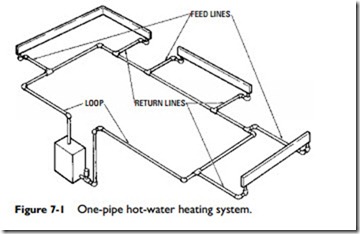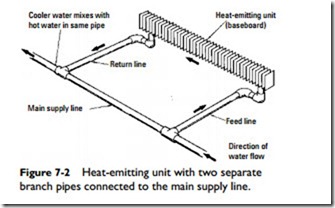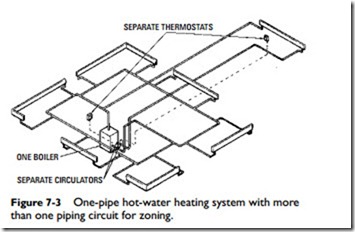One-Pipe System
A one-pipe system (Figure 7-1) is one in which a single main pipe is used to carry the hot water throughout the system. In other words, the same pipe that carries the hot water to the heat-emitting units (i.e., radiators and convectors) in the various rooms and spaces within the structure also returns the cooler water to the boiler for reheating. Each heat-emitting unit is connected to the supply main by two separate branch pipes (separate feed and return lines). (See Figure 7-2.)
The hot water flows from the boiler or heat exchanger (if a steam boiler is the heat source) to the first heat-emitting unit, through it to the second unit, and so on through each of the heat- emitting units in the one-pipe system until it exits the last one and returns to the boiler or heat exchanger.
One-pipe systems may be operated on either forced or gravity circulation. Special care must be taken to design the system for the temperature drop found in the heat-emitting units farthest from the boiler. This is particularly true of one-pipe systems designed for gravity circulation.
A principal advantage of a one-pipe system is that one or more heat-emitting units can be shut off without interfering with the flow of water to other units. This is not true of series-loop systems, in which the units are connected in series and form a part of the supply line.
In some large one-pipe systems, zoning can be achieved by pro- viding more than one piping circuit from the boiler (Figure 7-3). In such cases, each piping circuit is equipped with its own thermostat and circulating pump. Sometimes these circuits are erroneously
Related posts:
Incoming search terms:
- Hydronic Boiler System mail
- ganggyeong Refrigeration Heat Exchange Equipment mail
- Cheorwon Refrigeration Heat Exchange Equipment mail
- Structure of one pipe system
- single pipe hydronic heating system
- one pipe hydronic heat
- one pipe heating system
- Boiler Pipe mail
- httpsBOILER SUPPLY MAIN TU://www microsoft com/en-cOIME BOILER SUPPLY PIPE/windows
- Heating Units mail
- circulators for one-pipe hydronic systems
- USAF Standard 4 hydronic line test


